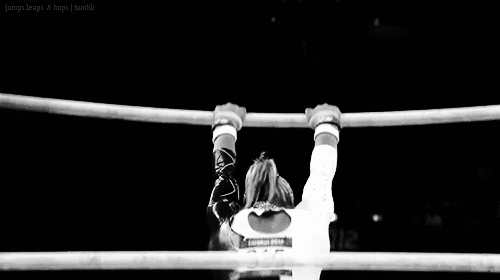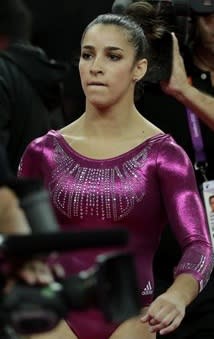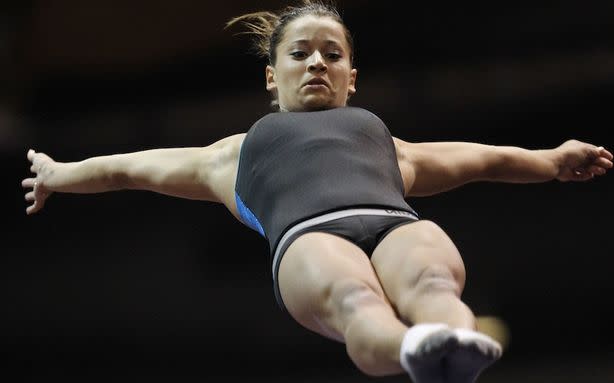Don't Let Boobs Ruin Your Sports Dreams
ESPN has published an entertaining think piece on the problem of boobs in sports. But it conflates two problems. There is a difference between having boobs so big you can't do some sports, and having boobs so big you get GIF'd all over the Internet.
RELATED: This Girl Is Not Afraid of You and Will Beat You Up
Amanda Hess writes:
But a mounting body of evidence suggests that [breasts] pose a serious challenge in nearly all corners of competition. Gymnasts push themselves to the brink of starvation to avoid developing them. All sorts of pro athletes have ponied up thousands of dollars to surgically reduce them. For the modern athlete, the question isn't whether breasts get in the way--it's a question of how to compete around them...
Large breasts are associated with back and neck pain, skin rashes, carpal tunnel syndrome, degenerative spine disorders, painful bra strap indentations and even anxiety and low self-esteem.
Back pain is a mechanical thing. Anxiety is a brain thing. Hess is trying to turn two issues into one, and it shows in interviews with female athletes. There are plenty of athletes for whom breasts are not a big obstacle. Golf coach Kellie Stenzel, a former player, teaches women how to tweak their swing to deal with boobs. No boob mountain is too high to climb: "Stenzel says... she's never seen a chest she couldn't coach into compliance." Retired South African beach volleyball player Alena Schurkova said, "I am 32E, and I have never found them to be a problem. I could be double what I have... and I would still be okay to perform."
RELATED: Goon Hockey Lives; The Golden State Warriors Can't Have People Over
On the other side, supposedly, are the gymnasts, Exhibit A in the case against boobs. Hess writes:
But nowhere do breasts pose more of a liability than in the world of elite women's gymnastics, where any hint of a curve can mean early retirement. "Look at missiles that shoot into the air, batons that twirl--they're straight up and down," says Joan Ryan, author of the 1995 expose of gymnastics and figure skating, Little Girls in Pretty Boxes. In order to stay stick straight, elite gymnasts undereat and overtrain, which delays menstruation. "You can't afford to have a woman's body and compete at the highest level," Ryan says.
RELATED: Jon Hamm Is Game; Old Beach Boys Save New Beach Boys
Ryan wrote a very popular and interesting book, but it's also terribly dated. In the late 1980s, the top athletes were mostly pre-pubescent, and the Soviet Union and communist Romania dominated, because it's easier for authoritarian governments to torture children. But today, the minimum international competition age is 16, which means most competitors are post-pubescent.
RELATED: Wimbledon Begins; Michael Phelps Returns; Drake Ruined Tony Parker's Olympics
Gymnasts don't need to be flat-chested, they need to be thin. If you want to flip a bunch of times high in the air, you need a high strength-to-weight ratio. And it is easier to stay skinny before puberty; kids tend to have a lower BMI. But because little kids aren't allowed to compete anymore, gymnasts compensate by getting really strong. Aly Raisman, who won the most medals of any American gymnast at the 2012 Olympics, has boobs—and massive traps. In the GIF below, post-pubescent German gymnast Elizabeth Seitz does a super-hard twisting skill—exactly the kind of skill Ryan says breasts make hard to do. The 2008 Olympian Alicia Sacramone (pictured above) is unfortunately well-known on the Internet both for her powerful vaulting and her big boobs.
RELATED: Crime in Syria, Reading in New York, and 'Into the Woods'
And that seems to be the real chest problem female athletes face: public boob humiliation. Serena Williams has big breasts, and Caroline Wozniacki put towels in her tank top to make fun of her. At the 1997 world championships, one of Nebiat Habtemariam's boobs popped out during her 18-minute, 5,000-meter run. UFC fighter Ronda Rousey says she felt conflicted over which would be worse: let her boob fall out of her too-big bra during a fight, or let her opponent snap her neck. (The neck was spared.) In fact, if you separate the mental boob issues from the physical ones, it's possible boob-binding is actually harmful! A recent French study found that bras are unnecessary and worsen sagging, possibly because they allow the muscles that support breasts to deteriorate.
Rousey, whose almost-nip slip got GIF'd, says "You don't see big titties in the Olympics, and I think that's for a reason." It depends on what she means by big titties. Though studies vary, the average American bra size is somewhere between 36C and 36D. But the average American woman is chubby. She's just under 5 foot-4 inches and weighs 166 pounds—overweight, and pushing obese. In other words, not in champion shape. Big boobs for an Olympian will be smaller than big boobs for a regular American. Deirdre McGhee, a senior lecturer at Breast Research Australia, says some girls quit sports when they get boobs: "They're embarrassed. They don't want to talk about it. And so they stop." But that is not the fault of boobs. It is the fault of terrible people on the Internet.



